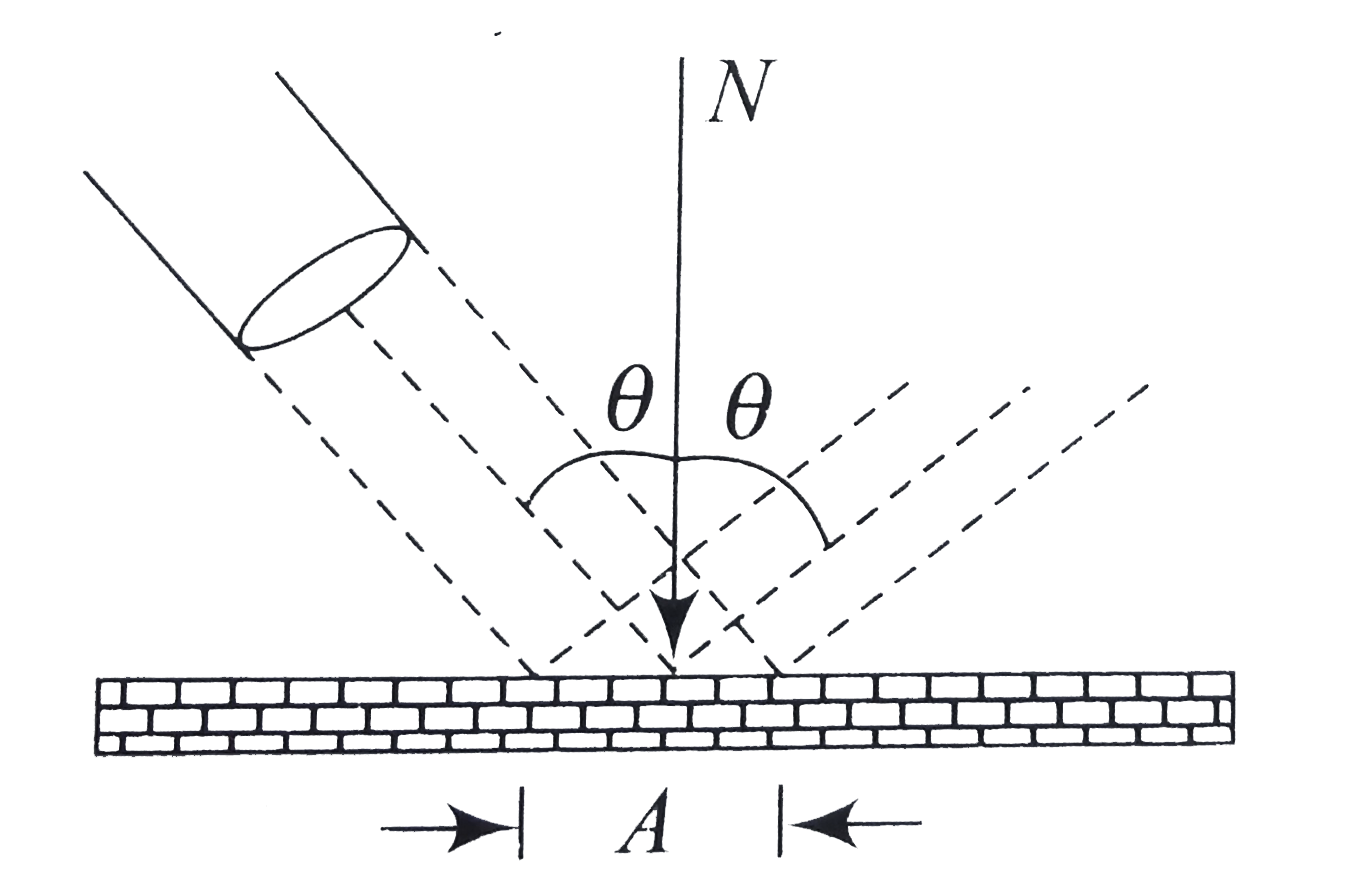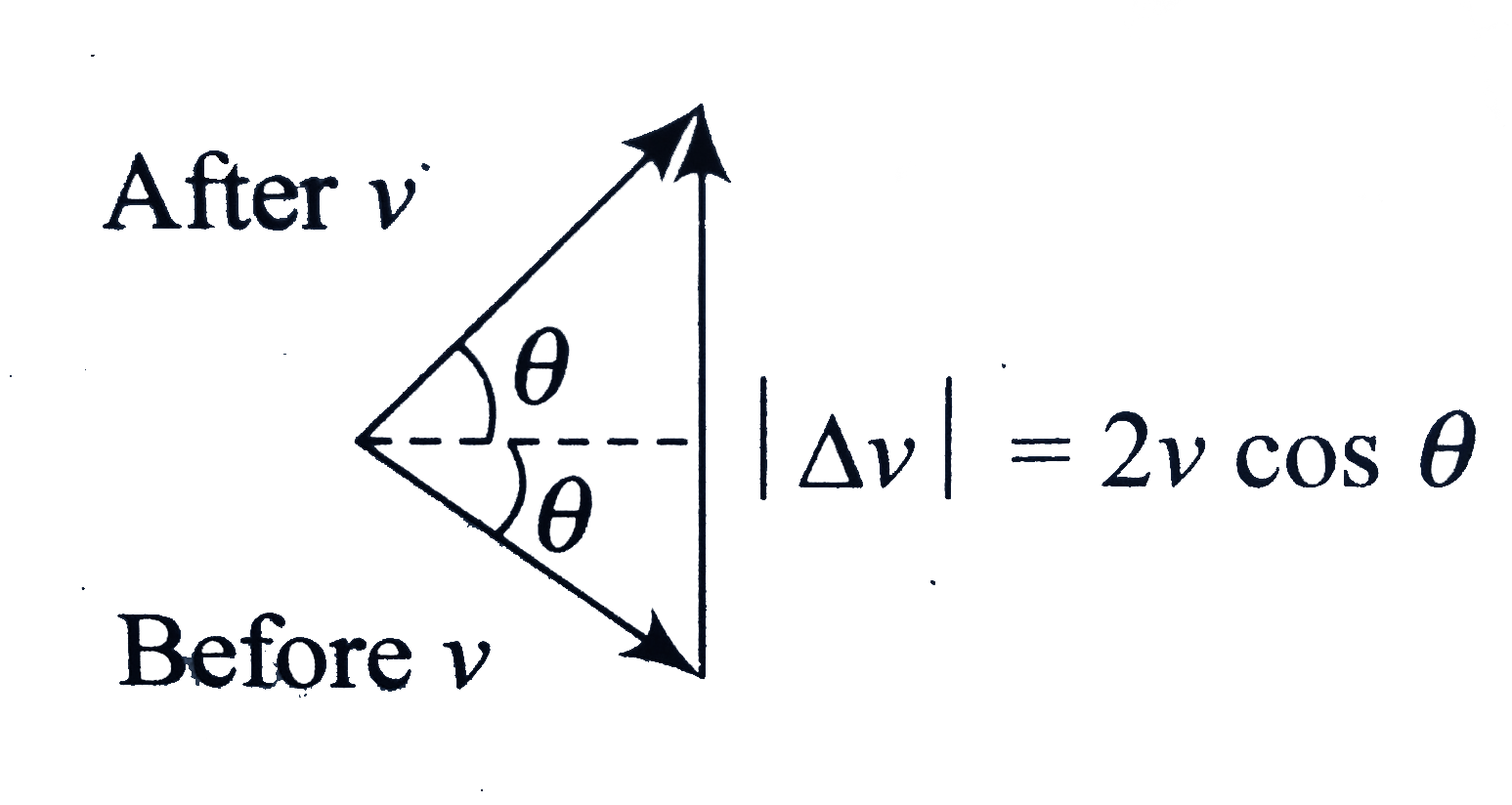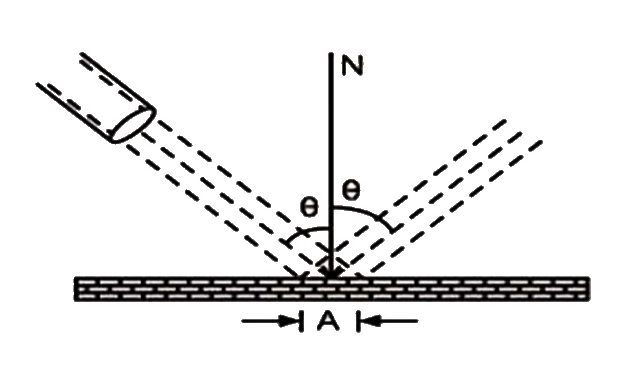
A nozzle throws a stream of gas against a wall with a velocity v much larger than the thermal agitation of the molecules. The wall deflects the molecules without changing the magnitude of their velocity. Also, assume that the force exerted on the wall by the molecules is perpendicular to the wall. (This is not strictly true of a rough wall). Find the force exerted on the wall
Anmv2cos2θ
2Anmv2cos2θ
2nmv2sin2θ
Anmv2cosθ
The correct Answer is:B

Since the molecules rebound from the wall, the component of velocity perpendicular to the wall is reversed, whole its velocity parallel to the wall does not change. The change is velocity of molecules is parallel to normal N. The magnitude of change is
|△→v|=2vcosθ
The change is momentum of a molecule is
|△→p|=m|△→v|=2mvcosθ
in the direction of normal N. Let n be the number of molecules per unit volume. The number of molecules arriving at an area A of the wall per unit time is the number in a slanted cylinder whose length is equal to the velocity v and whose cross section as Acosθ.
Number of molecules=n(Avcosθ)
Each molecule suffers a change of momentum 2mvcosθ.
Change of momentum of a steam of gas in a direction perpendicular to the wall is equal to (nAvcosθ)×(2mvcosθ)=2Anmv2cos2θ.
Hence, force exerted on stream of gas by the wall,
F=2Anmv2cos2θ
This is also the force exerted by gas molecules on the wall.
pressure=(normal force)/(Area)=FA=2nmv2cos2θ
Remark: for oblique incidence, the change in momentum of the radiation per unit volume at the perfectly reflecting surface is 2pcosθ and the corresponding radiation pressure is Prad=2pos2θ=2Ecos2θ
Topper's Solved these Questions
- BOOK - CENGAGE PHYSICS ENGLISHCHAPTER - PHOTOELECTRIC EFFECTEXERCISE - Multiple Correct10videos
PHOTOELECTRIC EFFECT
- BOOK - CENGAGE PHYSICS ENGLISHCHAPTER - PHOTOELECTRIC EFFECTEXERCISE - Linked Comprehension44videos
PHOTOELECTRIC EFFECT
- BOOK - CENGAGE PHYSICS ENGLISHCHAPTER - PHOTOELECTRIC EFFECTEXERCISE - Subjective16videos
PHOTOELECTRIC EFFECT
- BOOK - CENGAGE PHYSICS ENGLISHCHAPTER - NUCLEAR PHYSICSEXERCISE - ddp.5.514videos
NUCLEAR PHYSICS
- BOOK - CENGAGE PHYSICS ENGLISHCHAPTER - RAY OPTICSEXERCISE - DPP 1.612videos
RAY OPTICS
Similar Questions
A nozzle throws a stream of gas against a wall with a velocity v much larger than the thermal agitation of the molecules. After collision of the molecules with wall the magnitude of their velocity remains same. Also assume that the force exerted on the wall by the molecule is perpendicular to wall. (This is not strictly true for a rough wall.) Find the pressure exerted on the wall. (n = number of molecules per unit volume, m = mass of a gas molecule)
 View Solution
View SolutionAttractive force of cell walls of xylem for water molecules is termed as
View Solution
Knowledge Check
- Question 1 - Select One
A ball of mass m travelling horiozntally with velocity v strikes a massive vertical wall and rebounds back along its original direction with no change in speed. What is the magnitude of the impulse delivered by the wall to the ball?
A0B12mvCmvD2mv
A body of mass m collides against a wall with the velocity v and rebounds with the same speed. Its magnitude of change of momentum is
View SolutionIn turbulent flow the velocity of the liquid molecules in contact with the walls of the tube.
View SolutionA molecule of mass m moving at a velocity v impinges elastically on the wall at an angle α with the wall. Then
View SolutionA particle of mass m strikes elastically on a wall with velocity v, at an angle of 60∘ from the wall then magnitude of change in momentum of ball along the wall is
View SolutionA jet of water with cross section of 6cm2 strikes a wall at an angle of 60∘ to the normal and rebounds elastically from the wall without losing energy. If the velocity of the water in the jet is 12m/s, the force acting on the wall is
View SolutionWind with a velocity 100kmh−1 blows normally against one of the walls of a house with an area of 108m2. Calculate the force exerted on the wall if the air moves parallel to the wall after striking it and has a density of 1.2kgm−3.
View SolutionA stream of a liquid of density p flowin horizontally with speed v rushes out of a tube of radius r and hits a verticla wall nearly normally. Assumi g that the liquid does not rebound from the wall, the force exerted o the wall by the impact of the liquid is given by
View Solution

